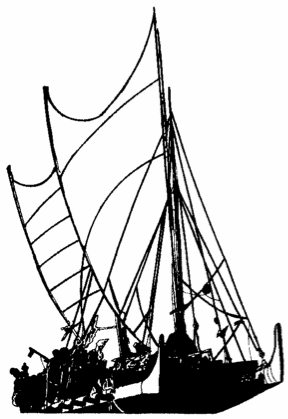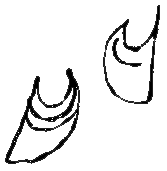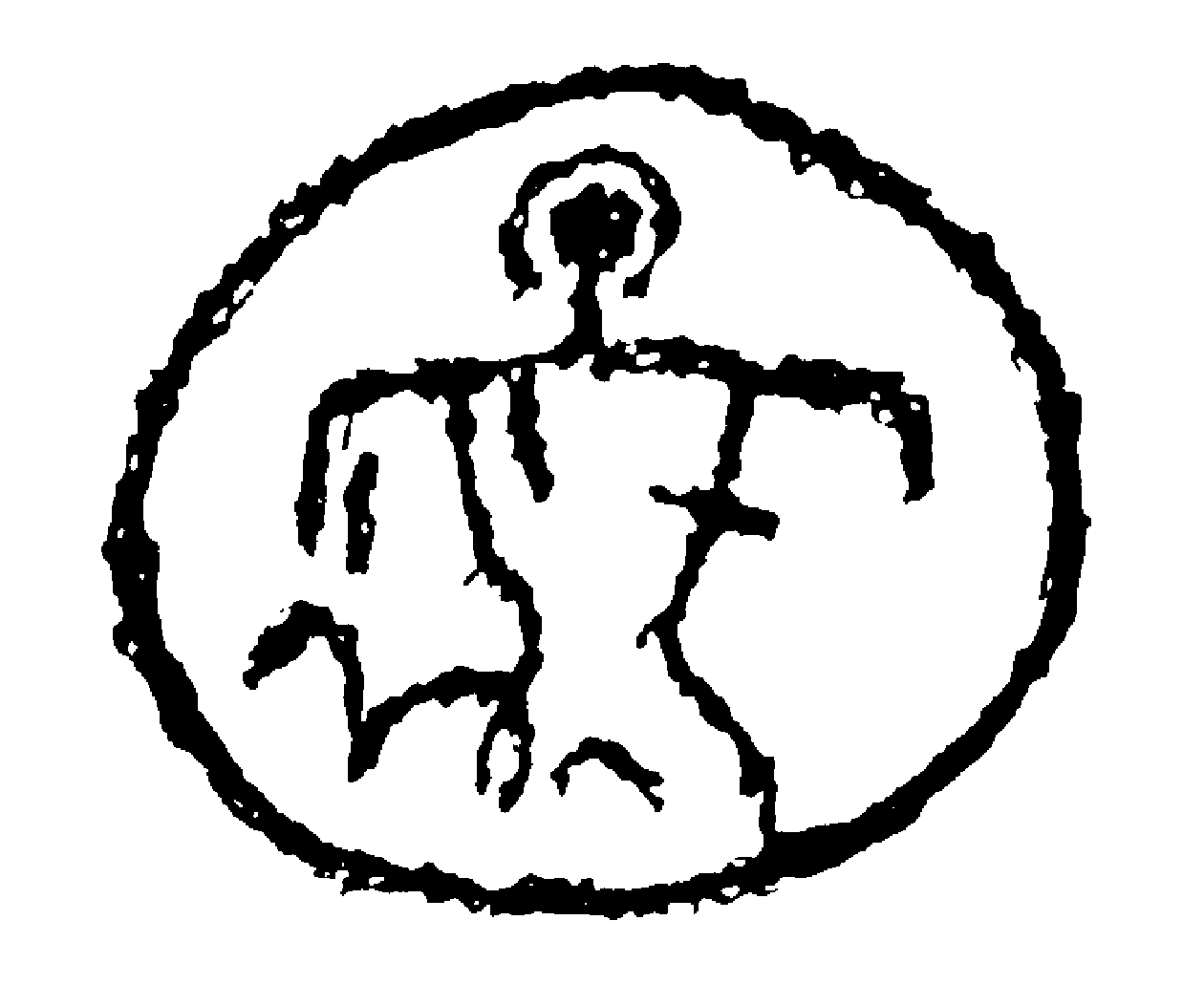PVS Newletter / Ho‘oilo (Rainy Season) 1998-1999
Closing the Triangle: A Quest for Rapa Nui
I lunga (upwind)
e tau (it juts up)
e revareva ro a (as a permanent contour
i roto i te raa (in the midst of the [rising] sun)
Directions to Rapa Nui, from a migration tradition of Rapa Nui
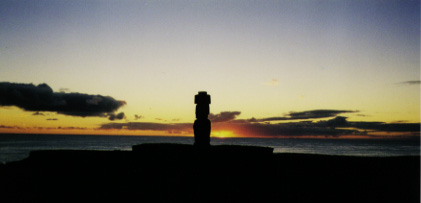
Moai on Rapanui. Photo by Sonny Ahuna
From June-October 1999, PVS is planning to culminate the last 25 years of voyaging--a generation of voyaging--with a voyage to Rapa Nui. Since Hokule'a was launched in 1975, it has touched every major island or island group in Polynesia except Rapa Nui. We sail to Rapa Nui to close the Polynesian Triangle, to make a connection with the far southeast corner of Polynesia and strengthen the bonds between the people of Hawai'i and Polynesia and the people of Rapa Nui, who are of one family.

We sail to honor the people who found and settled Rapa Nui. Rapa Nui is the most isolated high island on Earth, and its discovery and settlement by Polynesian voyagers is one of the great accomplishments of exploration in human history. How did they find such a small island, over a thousand miles upwind of the nearest Polynesian settlement?
We sail to honor our elders and küpuna and the many others who contributed to voyaging and its revival possible in the 20th century.
We sail to train a younger generation of deep sea sailors and navigators to perpetuate Hawai'i's proud traditions of voyaging and navigation.
We sail to explore our history and learn more about the history of Rapa Nui: By the time Europeans reached the island in the 18th century, it was practically treeless. No canoes. What happened to the trees? Because of the limited size of the island, perhaps the population outgrew the capacity of the island to support the people; or some natural disaster (e.g., a prolonged drought) may have caused the island environment to deteriorate beyond recovery. What lessons does the history of Rapa Nui have for Hawai'i and the planet earth?
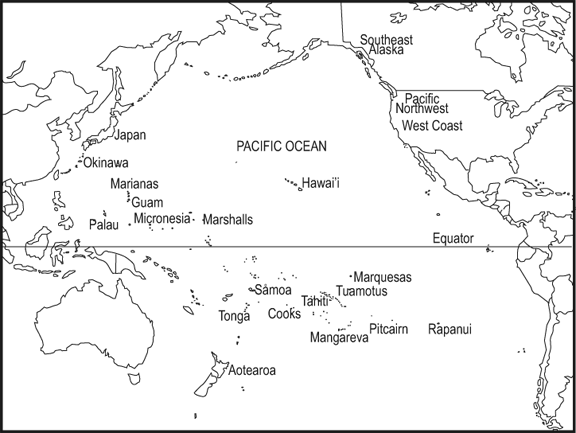
The Challenge
To get from Hawai'i to Rapa Nui, Hokule'a must travel to the 2820 nautical miles south (from 20 degrees N to 27 degrees S) and 2760 nautical miles east (from 155 degrees W to 109 degrees). The first three destinations (Nukuhiva, Mangareva, and Rapa Nui) lie upwind of the departure points, so the canoe will have to struggle to get east against the prevailing winds.
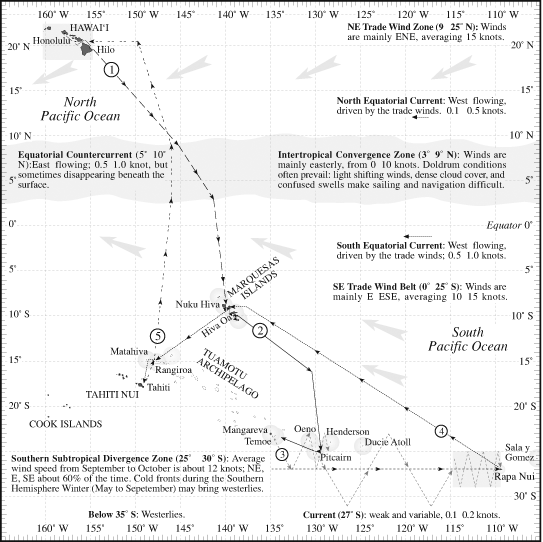
The sail from Mangareva to Rapa Nui will be the most difficult, as Rapa Nui lies 1450 miles to the east of Mangareva. On this leg, Hokule'a will be navigated without instruments by a team of Hawai'i's best navigators, headed by Nainoa Thompson. They will guide the canoe by celestial bodies (sun, moon, planets, and stars), ocean swells, and land-based sea birds.
Rapa Nui is a small, isolated island, making it a difficult target for the non-instrument navigator. Traditional non-instrument navigation, or wayfinding, cannot achieve the pinpoint accuracy of satellite navigation. The wayfinder sails into the vicinity of his destination and begins looking for the island. He may find an island close by and re-orient the canoe to his destination. The fact that many islands in the Pacific are part of island chains, with relatively closely-spaced islands made this sort of navigation practical in ancient times. However, there are no islands close to Rapa Nui. Pitcairn, the nearest inhabited island, is 1150 miles to the west.
Furthermore, Rapa Nui is a small, low island, a triangle 13 x 11 x 10 miles, whose highest point is the 1674-foot Terevaka.
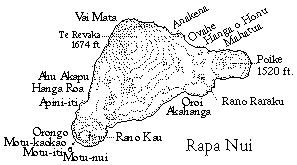
To find this island, the wayfinders will have to sail within 46 miles of it, in clear weather, during daylight hours. (Formula for seeing objects at sea: Distance in Nautical Miles = Square Root of the Object's Height (in feet) + Square Root of Observer's Height (in feet; the height of the observer on the canoe, when the observer climbs the mast, is approximately 25 feet high).
The wayfinders plan to use dead reckoning (estimating distance sailed, based on estimates of direction, speed, and time) and latitude stars (see below) to get within a couple hundred miles of Rapa Nui, then employ a zigzagging search pattern along the latitude of Rapa Nui (27 degrees S) to find the island. The zigzags in the pattern must be close enough together, so that the canoe will not sail past the island unseen just over the horizon.
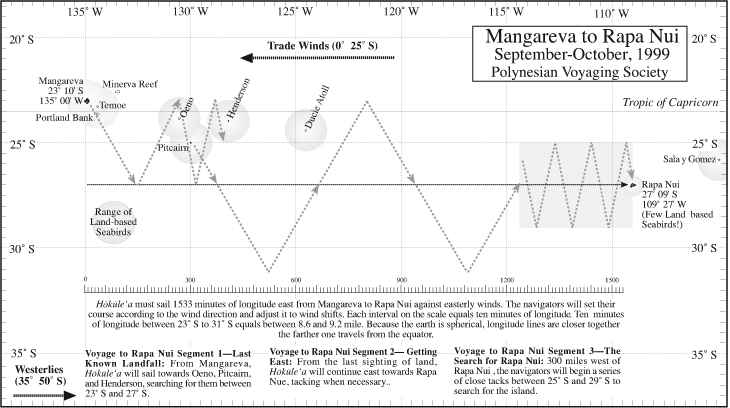
Wayfinders in the Pacific have traditionally used land-based seabirds flying home in the evening or flying from home in the mornings to fish. This clue to the direction of land expanded the target island, by a radius of up to 150 miles around the island. Once Rapa Nui had a thriving population of seabirds. In 1934-35, while conducting research on the island, Alfred Metraux reported gray, white, noddy, and gray-backed terns, as well as boobies, tropic birds, and frigates. Today Rapa Nui has few seabirds. A hawk introduced to the island to control the rat population has reduced the bird population. Thus, this landfinding technique is no longer available to the Hawaiian wayfinders.
The quest to reach Rapa Nui will be made in the early spring of the Southern Hemisphere (September-October), when storms around Antarctica may break down the easterly trade winds and bring westerly winds. The wayfinders will observe the weather patterns that set up to figure out the best strategy for reaching the island. Starting on September 15, the crew on Mangareva will wait for favorable winds to launch.
The voyage to Rapa Nui is the most challenging voyage undertaken by the Polynesian Voyaging Society; the results are uncertain. The probability that the wayfinders will find the island is not high. The highest priority is the safety of the crew. In searching for Rapa Nui, PVS will place a time limit on how long the crew will search for the island-around 40 days, after which limited food and water and fatigue may become safety issues. But whether the Hokule'a reaches Rapa Nui or not, we know that the early Polynesians did so.
Beyond reaching the destination, what is important for the Polynesian Voyaging Society is to honor the great achievements of our Polynesian ancestors, to learn what we can about how they accomplished what they did, and pass on what we learn to future generations.
[Note: Hokule‘a reached Rapanui on Oct. 8, 1999. For the story of the amazing, improbable 19-day, 1,450-mile voyage from Mangareva to the most remote and isolated island in Polynesia, see “Gift of the Wind, Aboard Hokule‘a on her Miraculous Journey to Rapa Nui”; other writings on the voyage appear in the menu to the right of “Gift of the Wind.”]
MALAMA HAWAI'I: A Contribution to Hawai'i's Future
Malama Hawai'i ("to care for and protect Hawai'i") is an initiative of the Polynesian Voyaging Society and The Queen's Health Systems. It was established in 1996 to create opportunities for people and organizations to take responsibility for & strengthen what we value about Hawai'i, our special island home. Malama Hawai'i has adopted the following vision and mission:
VISION
Hawai'i, our special island home, is a place where the land and sea are cared for, and communities are healthy and safe.
MISSION
Malama Hawai'i is dedicated to making a meaningful and on-going contribution to the health and spirit of Hawai'i's land and sea, and the quality of life of all of Hawai'i's people through education and community-building.
GUIDING VALUES
- Aloha: Love
- Malama: Care For
- ‘Imi ‘Ike: Seek Knowledge
- Lokomaika‘i; Share with Each Other
- Na‘au Pono: Nurture a Deep Sense of Justice
- Olakino Maika‘i: Live Healthily
GOALS
In order to achieve our mission, Malama Hawai'l has adopted the following goals and projects:
GOAL 1. Celebrate the last 25 years of Pacific voyaging and exploration, the rediscovety and renewal- of Hawaiian culture, and its contribution to Pacific 12eoples and their s,pecial island environments.
Project 1. Closing the Polynesian Triangle – By accepting the great challenge to voyage to Rapa Nui in 1999, Malama Hawai'i will celebrate 25 years of renewing the voyaging traditions of Hawai'i and Polynesia.
Project 2. Celebrate the 25th Anniversary of the Launching of Hokule‘a – In the year 2000, Malama Hawai'i will celebrate the 25th anniversary of the launching of H6k(ile'a (launched in 1975) and the achievements of 25 years of voyaging.
Project 3. Conduct a Statewide Sail – As part of the Voyaging Celebration in the year 2000, Malama Hawai'i will conduct a Statewide Sail visiting 31 communities between March and October.
Project 4. Conduct Associated Voyaging Education Programs – During the voyage to Rapa Nul and the Statewide Sail, Malama Hawal'i will conduct education programs to focus on the importance of exploration and the need to work toward a sustainable future for Pacific islands.
GOAL 2. Promote stewardship and caring for Llawai'i through education and communiiy partnerships.
Project 1. Establish the Hawai'l Ocean Learning Center. Malama Hawaii will establish the Hawai'i Ocean Learning Center in order to make a contribution to quality education and the stewardship of Hawai'i's ocean.
Project 2. Build a 21st Century Canoe for Education (Hokule‘a II): As part of the Ocean Learning Center, Malama Hawai'i will construct a modern sailing canoe (a catamaran) to serve as an ocean classroom for its exploration, education, and stewardship programs.
Project 3. Develop Malama Hawai'l Education Programs and Curriculum: Malama Hawai'i will develop cultural and environmental education curricula and programs (K-12 to College) to encourage students to contribute to the mission of Malama Hawai'i.
Malama Hawai'i Education Programs
in conjunction with the Rapa Nui Voyage (1999) and the Statewide Sail (2000), Malama Hawai'i will assist itseducational partners in developing and disseminating culturally relevant curriculum about voyaging. The educational partnerships that have formed around the voyage will use mociern educational technology and the media to bring the voyages of Hokue‘a to 100,000 students and adults-across the state ana nationally.
Partners in the project include the State Department of Education, the University of Hawai'i, Hawai'i Association or Independent Schools, Kamehameha Schools Bishop Estate, Bishop Museum, Moanalua Garden Foundation, Pacific Resources for Education and Learning, the Hawaiian Academy of Science, and the Public Broadcasting System.
These education programs will:
- explore the idea of how to live well on islands.
- institutionalize culturally relevant curriculum about voyaging in the eciucational system, as a way to sustain the important lessons that have been learned through voyaging.
- communicate powerful messages about Malama Hawai'i's nine themes. (See below.)
- motivate students to work together toward the Malama Hawai'i Vision.
The long term goal of the Malama Hawai'i education projects is to transform education in Hawai'i by integrating our vision, themes, and values into school curriculum, from K-12 and college.
To make a contribution to quality education and the stewardship of Hawaii's ocean, Malama Hawai'i will also develop the Hawai'i Ocean Learning Center. in partnership with the State of Hawai'i Department of Education, the University of Hawai'i, the Hawaii Institute of Marine Biology, the Department of Land and Natural Resources, and community organizations. The Hawai'i Ocean Learning Center will:
- contribute to the health of the larger community by caring for the health of our ocean.
- allow students to learn more about their ocean environment.
- gather sound information about our ocean s resources in order to make good management decisions.
- provide teacher training and technical expertise in ocean safety and activities to schools and colleges with voyaging programs.
- allow students to apply what they learn to the stewardship of Hawaii's oceans.
- prepare qualified students for a career in an ocean-related field.
As part of the Ocean Learning Center, Malama Hawai'i will construct a modern sailing canoe (a catamaran) to serve as an ocean classroom to support our programs of exploration, education, and stewardship.0
Nine Key Themes for Education
Since Hokue‘a was launched by the Polynesian Voyaging Society in 1975, she has sailed more than 90,000 miles, equal to nearly three times the circumference of the Earth, touching nearly every corner of the Polynesian Triangle and the West Coast. Her voyages sparked a renewal of interest in traditional Polynesian voyaging and navigation, and H6kfile'a has become a symbol of the proud sea-faring heritage which links together the peoples of Polynesia.
Over the last 24 years, the community surrounding the canoes has volunteered more than 3 million man hours to care for and sail Hokule‘a, and her sistercanoe Hawai'iloa. This community is not defined by geography or ethnicity, but rather by a common vision and shared values, and the desire to make a contribution to Hawai'i's future.
The last 24 years of exploration, recovery of Polynesian voyaging traditions, and work with communities across the Pacific, has taught the Voyaging Society the importance of the following nine guiding themes:
- VISION – Given the enormous changes that our islands face in the 21st century, we must form a collective vision of what we want our future to look like, and how we will reach that vision.
- EXPLORATION – The importance of exploring and learning about the world around us is essential to finding solutions to the difficult issues of our times.
- OUR HISTORY & HERITAGE, OUR TRADITIONS & CULTURE –Our precious inheritance defines who we are, where we come from, and why we should be proud.
- OUR SACRED EARTH – By learning to care for the planet Earth and all living thing, we will learn to care for our future
- BALANCING THE NEEDS OF PEOPLE & NATURE – Achieving a balance betweem human needs and nature was one of the greatest accomplishments of the Hawaiian people, and recreating it in these modern times is one of our greatest challenges.
- OUR PACIFIC 'OHANA – One of mankind's greatest needs is to feel a sense of kinship with other people and establish caring relationships with one another.
- OUR KUPUNA AND 'OPIO / ELDERS AND YOUTH – Treating our elders with respect and dignity and nurturing and guiding our youth, beginning with early childhood care and education, are essential to our well-being.
- THE HEALTH & EDUCATION OF OUR FIRST PEOPLE – Hawaiian culture and values and a healthy, educated Hawaiian community are vital to shaping a healthy, safe future for Hawaii.
- OUR SPECIAL MULTI-ETHNIC COMMUNITY & CULTURE – Our special multiethnic community is Hawai'i's contribution to global peace.
These nine themes are about the same thing--our relationship to nature and to one another. As we approach the 21st century it is critical, now more than ever, that we learn to live well on islands, caring and respecting each other and all living things. The Polynesian Voyaging Society believes that addressing these nine themes are vital to a healthy future for these islands.
Year 2000: Celebrating the 25th Anniversary of the Launching of Hokule‘a
During the year 2000, Malama Hawai'i will coordinate and complete projects celebrating the 25th anniversary of the launching of Hokule‘a. The celebration will begin with the United Nations Youth Millennium Conference (Oct. 1999) and include an event at Hakipu'u/Kualoa on March 6, 2000, where Hokule‘a was launched on March 6, 1975. The celebration will bring together the people of Polynesia in a meeting of the Polynesian Union and other peoples of the Pacific, including a contingent and canoe from Alaska.
The celebration will:
- recognize the cultural value of Hokule‘a to the State of Hawai'i.
- contribute to efforts to strengthen health, culture, and education in communities across the State and internationally.
- make a positive contribution to the renewal of the culture, environment and health of the people of Pacific.
- strengthen the bonds and promote cultural understanding among the peoples of the Pacific.
- recognize and celebrate the accomplishments of ancient Polynesian voyagers
- and the achievements of the last 25 years of voyaging.
- honor our kupuna and teachers, and all those who made great contributions to voyaging, but who are no longer with us.
- gain support for developing learning sites for Hokule‘a in culturally appropriate places statewide.
As part of the Voyaging Celebration in the year 2000, Malama Hawai'i will conduct a Statewide Sail visiting 31 communities between March and October. This sail will be an opportunity to:
- contribute to each community's effort to strengthen health, culture, and education.
- continue training crew members and navigators as instructors and resource people for educational programs.
- reconnect with communities across the state and show appreciation for their support of voyaging.
In order to care for and maintain our voyaging canoes and create culturally appropriate learning sites statewide, Malama Hawai'i will:
- build a canoe halau at Hokule‘a Beach in Hakipu'u.
- work for a special designation to create moorings for voyaging canoes around the state at canoe education sites.
- conduct canoe education programs.
- develop a long term plan for maintaining Hokule‘a, Hawai‘iioa, and Eala, and building and caring for Hokule‘a II.
PVS Officers and Board of Directors, 1998-1999
Officers: Myron "Pinky" Thompson, President; Keali'ipu'aimoku Froiseth, V-President; Dawn Gohara, Treasurer; Bob Worthington, Secretary
Directors: Wally Froiseth, Catherine Fuller, Brickwood Galuteria, Harry Ho, Rey Jonsson, Lilikala Kame'eleihiwa, Wiliam Ornelles, Dr. Ben Tamura, Laura Thompson, Michael Tongg, Dr. Nathan Wong, Elisa Yadao, August Yee
Consultant: Ben Finney
